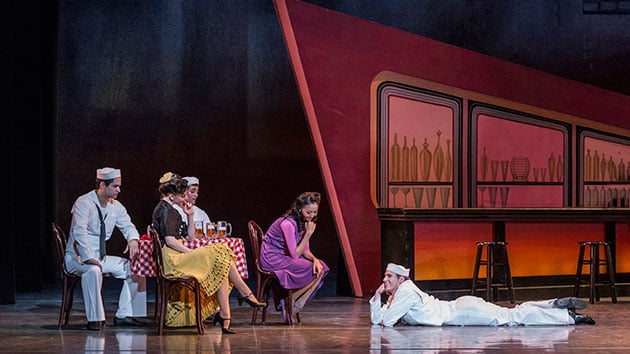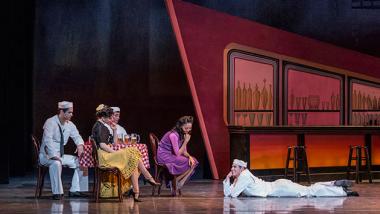
Fancy Free, whose company premiere Friday highlighted Ballet San Jose Silicon Valley’s first repertory series, wouldseem a natural for the troupe. Now a close ally of American Ballet Theatre, its artistic director, stellar ABT alum Jose Manuel Carreno, was known for his macho participation in Jerome Robbins’ classic romp about three sailors on shore leave, the bones of which were to lead to the smash musical On the Town, now in Broadway revival, and thence, via Gene Kelly and Frank Sinatra, to the movie version and immortality.
Fancy Free, created when Robbins was still dancing with Ballet Theater, remains one of his greatest works, also paving the way for landmarks by its young and brilliant composer, Leonard Bernstein.
So entertaining, debonair and practically perfect was Friday’s performance that what it took to get it on its feet might well be left in the dust. That would be a shame. Robbins, for all his genius, was never a fancy-free choreographer, and without the precision he dictated, from inception through its passage from Ballet Theater, as the company was then called, down to the present, when it remains a staple of the New York City Ballet, ABT, and dozens of fortunate troupes around the world, Fancy Free would be oh, less than nothing. So entertaining, debonair, and practically perfect was Friday’s performance that what it took to get it on its feet might well be left in the dust.
But, like most great choreographers, Robbins left orders in place to guarantee that his work would be staged the way he wanted it staged. We also see this, of course, in the work of George Balanchine and Twyla Tharp among many others; both of them were also represented Friday in Theme and Variations, a BSJ standard, and In the Upper Room, which joined the rep last year.
The way staging happens is in part through the sharing of dancers’ physical and performance recollections – dance being very much a “body to body” art form, as Edward Villella says – as well as film and notation (and pointed remarks) directly from the creator. So the stagers for these three ballets, designated by the respective artists and their trusts, worked with Ballet San Jose’s dancers to make everything the way it ought to be. They were (Fancy Free) Philip Neal, who danced for Robbins when he was co-ballet master-in-chief (whew) at the New York City Ballet; (Theme and Variations) Sandra Jennings and Stacy Caddell for the George Balanchine Trust, also at City Ballet, and (In the Upper Room) two former Tharp dancers, the great Shelley Washington, and Gil Boggs (now Colorado Ballet’s artistic director).
Of the three, Fancy Free was the standout, rising way above the tinny, taped music (Ballet San Jose, still woefully short of funds, could not reach an agreement for the services of Symphony Silicon Valley). Richly nostalgic with its angular Oliver Smith bar-room set design and Bernstein’s score, its keen rhythms evoking his fascination at the time with things Latin, plus the entire notion of carpe diem or, dare we say, dame – it was, after all, shore leave in the middle of World War II; everything, particularly the rhumbas, the moments of boyish brooding, the fights, the flirts, the resilience, the friskiness of the chase, all of it came together at the San Jose Center for the Performing Arts so precisely, with fine technique and such wonderful, readable nuance.
In the small cast, the great performances abounded: Rudy Candia, Walter Garcia and Joshua Seibel as the gobs; Grace-Anne Powers and Ommi Pipit-Suksun as their leggy quarry, and, in smaller roles, Emma Francis as a last-minute distraction, and James Kopecky as the long-suffering bartender.
Theme and Variations, all satin, tutus, Tchaikovsky (Suite No. 3 for orchestra) and chandeliers, went off without many hitches, though this taxing and stunning opener needed a few moments for the company to hit its stride. In the leads, principal dancers Junna Ige and Maykel Solas were prodigies of durability and grace, drawing in all viewers for the central ballet, Balanchine’s wonderfully intimate, tender yet frolicsome pas de deux.
Again, not to beat a dead horse, this company desperately needs, absolutely requires, live music. I can’t think of a ballet company that doesn’t. The likely exception would be for In the Upper Room, whose Philip Glass score might really demand the ministrations of a full-time and totally unaffordable company orchestra. On Friday, the audio sounded as good as anyone else’s, which isn’t really as grudging as it sounds, if you love Glass as much as this viewer. … this company desperately needs, absolutely requires, live music. I can’t think of a ballet company that doesn’t.
As noted here before, this – thanks in no small part to Glass – is one of the great creations of Tharp or anybody else. It flies by, and the minute it’s over, you want it all again. Is it the dry-ice fog, the lights, the Norma Kamali black-and-white prison pj’s contrasted with red tops and toe shoes, or white sneakers and shirts? Nah. It’s Twyla, first, last and always. Nobody has ever pointed up as viscerally what it means to dance and perform, in so many ways, as she does. (Oh, we could perhaps argue that her Push Comes to Shove is equally brilliant in this argument, plus it came equipped with Mikhail Baryshnikov at its premiere. But no.)
At any event, Ballet San Jose, even on its uppers, gets and represents In the Upper Room to the marrow of its bones. This company needs – and all of us need it – to keep on dancing.

